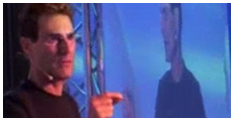Chapter 14
Sudden changes of temperature have often been reported in house-haunting phenomena. What is the possibility of there being paranormally produced temperature changes brought about by the remote action of a subject on a thermometer or similar instrument? Some years ago a report was published by the American parapsychologist Gertrude Schmeidler(36) about the thermal effects produced by the psychic Ingo Swann. It was shown that he was able to bring about resistance changes in a thermistor at distances of several metres. Some follow-up reports appeared, and one by Danish physicist Richard Mattuck(37) concerned the rising of mercury in a thermometer brought about by a Danish metal-bender. These publications, together with numerous descriptions in the literature of temperature effects in seances and hauntings, led me to consider the possibility that during metal-bending events there might be changes of temperature. Jean-Pierre Girard has been reported to have affected liquid crystal paint at a distance of several metres.(38) The changes of colour exhibited by these recently developed paints under temperature variation present an attractive goal to the psychic.
Temperature is a measure of the mean of the random speeds of motion in solids, liquids and gases, so that the elevation of temperature may not itself represent a primary physical phenomenon. For example, a shock wave produced by impact dissipates its energy in the form of a rise in temperature, and the action of a compression piston on a gas has a similar effect. The normal bending of a metal is accompanied by a local change in its temperature, and the stretching (back) of such materials as rubber is accompanied by a fall in temperature.
Resistive strain gauges are temperature-compensated; that is, they are designed so that the resistance is invariant to small changes of temperature. Therefore our dynamic strain signals are not due simply to small changes of temperature. However, the dynamic strain pulses are probably accompanied by minute local temperature changes, to which the gauge would not respond.
There are well-known devices, including thermistors, whose electrical resistance is very sensitive to temperature, but very much less sensitive to strain. If we wish to investigate the possible existence of temperature changes during metal-bending, such devices can be attached to metal specimens and chart-records made of the time variation of their resistance. I carried out such experiments with Stephen North, using the temperature gauge type STG 50D made by Micro-Measurements Inc. The sensor, which is formed of a nickel filament enclosed in epoxy-resin and glass fibre, has a nominal resistance of 50 Ohm and was used with resistive compensation in our standard 120 Ohm arm bridge. Resistive strain gauges were also mounted on the metal specimen, and strain pulses were recorded during the sessions, including a permanent bend.
I have at no time in these sessions observed any sudden temperature change at a thermal sensor. The high thermal conductivity of the metal specimen makes it possible to detect temperature changes over an area rather wider than that of the thermal sensor, whose dimensions are 12 X 9 mm. The sensitivity of the equipment is such that changes of less than one-fiftieth of a degree could be detected. Thus the proximity of the subject’s hands, and local air currents, were both detectable as relatively gradual temperature changes. Stephen North soon understood the magnitude of these effects and succeeded in keeping sufficiently far from the sensor to avoid serious interference. No dynamic signals of any significance were recorded on the temperature charts during these sessions, although strain pulses were recorded. I have not pursued thermal sensor studies in extenso because of the initial absence of signals; but it seems unlikely that anything more than highly locaised temperature effects are produced by metal-benders.
However, this is not evidence that there are not minute local secondary temperature changes occurring when the resistive strain gauges receive dynamic strain pulses. Italian physicists have reported macroscopic temperature rises in specimens stroked manually by metal-bender Orlando Bragante.
It has been remarked by Dr Crussard that some structural changes instigated by Jean-Pierre Girard would have required a temperature of 600°C to bring them about. It might be inferred that locaised regions of high temperature existed at points in the metal. Further evidence comes from magnetization data.
One reason why an elevated temperature can bring about a structural change is that chemical and physical reaction rates in general increase exponentially with temperature; thus if one structure is being formed continually but immeasurably slowly at room temperature, then an elevated temperature will favour its rapid formation. A familiar situation is that one structure is the most stable when the atoms are in faster motion, and another structure is the most stable when they are moving more slowly; the conversion from one to another is known as a phase transition. But the onset of fast motion does not imply the immediate attainment of local thermodynamic equilibrium. There are non-equilibrium ways of inducing structural change – for example, bombardment with nuclear radiation – which are effective without inducing much heat. If the psychic induction of structural change is a non-equilibrium process, then the paranormal production of temperature is only a secondary phenomenon; the atomic events leading to the structural change should be regarded as the primary phenomenon.


Latest Articles

Motivational Inspirational Speaker
Motivational, inspirational, empowering compelling 'infotainment' which leaves the audience amazed, mesmerized, motivated, enthusiastic, revitalised and with a much improved positive mental attitude, state of mind & self-belief.



















